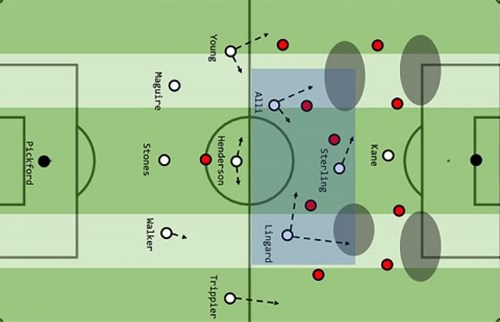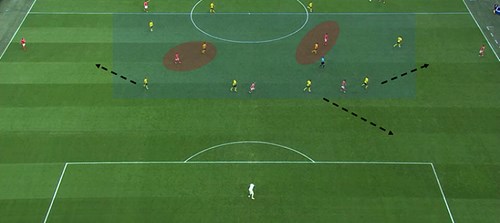By David Horrocks, MSc Football Coaching & Analysis Programme Leader at Etihad Campus, Mike Phelan and UCFB Alumni James Radcliffe
David has recently submitted a PhD thesis on elite performance completed with players and staff from Manchester United Football Club. The thesis has two published papers to date: Manchester United and Serial Winning, and Gary Neville – A Case Study. David also has a first class degree in Sport Psychology from the University of Central Lancashire.
Each time the world cup comes around, new stars are born, the transfer market goes crazy and the world is an open mic stage to stardom for every footballer involved. Who will be this year’s previously unidentified flying object and earn a big money transfer to one of Europe’s football powerhouses just like Colombia’s James Rodriguez did in Brazil 2012.
The Sensible Soccer World Cup blog will bring scouting know how direct from the battlefield of English Premier League recruitment directors and chief scouts. The blog will be opening the lid on just who is being watched ahead of Russia’s six-week footballing bonanza.
England – Just two wins away from a World Cup final place…
Whisper it, but Gareth Southgates’ side are two wins away from the monumental achievement of a World Cup final. With Germany, Spain, Argentina and Portugal all having left the party, Englands destiny is very much in their own hands.
Since Southgate took over England have adopted a new philosophical basis an impressive set-piece threat, and what’s more we’ve even won a penalty shoot-out. The FA’s extensive research and psychology team have left no stone unturned with regard to this year’s World Cup and the manager has embraced this.
Let’s look at how they’ve made it to the final eight.
England’s 3-5-2
England’s victories against Tunisia and Panama were two of the more dominant showings in the tournament so far. The 3-5-2 system has paid dividends with players being used in roles that suit their profile rather than past policies of square pegs in round holes.
Southgate appears to have observed and learned a great deal from his many sightings in the director’s boxes at The Etihad Stadium and beyond on his nationwide travels throughout last season.
The new system allows the dynamic trio of Dele Alli, Jesse Lingard and Raheem Sterling to demonstrate their abilities both on and off the ball and aids with the breaking down of deep block like defensive systems.

The above graphic shows how the triad operate relatively centrally in the half-spaces between the wide and central midfielders of the opposition. The shaded areas highlight the spaces afforded for Alli and Lingard as interiors to move into and cause problems for the opponent. This is shown here in a video detailing an example from the Tunisia game where Lingard reacts to Kane’s movement and attacks the vacated space creating a goalscoring opportunity.
Such movement not only aids the attacking players but also benefits the back 3/5 and in particular Jordan Henderson when building up through the first phase. The movement forces back the midfield line of the opposition leaving them unable to press due to what’s happening in the spaces in behind them.
England have also been adaptable through tactical substitution in this tournament although the changes at times have not been entirely convincing. Against Colombia the 3-5-2 structure altered and became what appeared a 5-2-1-2 .When England reshuffled the pack in the last 10 minutes against Colombia with the introduction of Dier and Vardy for Alli and Sterling this not only altered the system but totally changed the momentum of the game.

The above graphic from hudl.com, shows a momentum swing in favour of the Colombians around the 80th minute mark which coincides with the introduction of Eric Dier. Dier came in alongside Henderson to form a double pivot in front of the 3 centre-halves with Vardy slightly above Kane and Lingard roaming from left to right depending on the ball location. One can only assume that Soutgate thought the game was won and that shutting up shop would see them home.
These changes invited pressure from Colombia and all of a sudden Pickford and his three central defenders became busy men, most certainly in the period 80 through to 105.
There is no doubt Southgate will have studied the data in the aftermath and unless a commanding lead is evident or injury dictates it would be surprising to see Dier and Henderson in that tandem role again.
Set-Pieces
122 goals have been scored in the group stages, 51 from set-pieces, a significant high of 42% – and of those 51 goals, 33 of them were scored by teams progressing to the knockout stage.
England are the team most synonymous with set-piece success. Since Gareth Southgate has taken over the national side, 9 of the 35 goals scored under his tenure have been via set-pieces – a coach-record high of 26% for an England side.
Southgate has stated “We’d identified them (set pieces) as key in tournaments, and an element we felt we could improve upon.” Midfielder Ruben Loftus-Cheek elaborated on this by saying, “We’d been spending a lot of time on set pieces, right down to the details, all the runs and the blocks. To see it coming out on the pitch is great.”
Southgate has been meticulous in his research and has visited the Seattle Seahawks and attended and conversed with NFL analysts and NBA coaches in his preparation. They spent time detailing and analysing how their players create space in tight areas, how to time their runs through subtle movement, and the legal screening of opponents in these alterante sports. This has now clearly translated itself into England’s practices and this video shows an example where Ashley Young blocks off a defender to create space for John Stones.
Should England progress to the latter rounds of this World Cup, their so far fruitful system and set-piece sequences will be one of the key aspects which determine these increasingly tight knockout stage matches.
Sweden
Saturday’s clash against Sweden offers a very different conundrum to what England have faced to date. The Belgium game ultimately turned out to be nothing more than a training game, Tunisia pressed us in a mid-block shape, Panama were nothing but statues and Colombia packed the midfield but also also threatened at times and showed that in the latter stages there are times when the opponent has the ability to and will go for the win.
Sweden should not be underestimated going into this game, they navigated a group with France and Holland, beat Italy in a play-off tie and then qualified out of a group with Germany and Mexico. Without doubt, they’ve had the most difficult journey to the quarter-finals out of any nation. The key aspect of Swedens play is deep block the route to goal defending, defending as an eleven and then a reliance on counter-attacking strategies.

The above example shows their traditional 4-4-2 defending shape, it exhibits compactness through the midfield and defence without conceding too much space in any danger areas. The example demonstrates that the only attacking avenue for Switzerland to explore was through the wide areas and a cross into the box. However, even this scenario Sweden thrive upon with the narrow back four of Lustig, Lindelof, Granqvist and Augustinsson more than capable of competing aerially and clearing any danger.
Their ability to compete aerially is reciprocated in their prowess from set-pieces – Sweden have only conceded one goal from a set-piece, which in itself was a sublime strike from Toni Kroos. They’ve also scored from three set-piece scenarios, albeit two were penalties.
England have been equally as strong from those conditions but have also conceded their three goals to date from a corner, a free-kick and a penalty. In order to compete with the Swedes prowess from dead-balls, England will look to Stones, Kane and Maguire primarily.
Maguire in particular the Leicester centre-half has won 23 aerial duels so far this tournament, an average of 5.8 a game and won a tournament high 11 against Colombia. However 100% concentration is key and could be the difference between a semi final or a flight home. Maguire was outjumped and caught wrong side and unable to see his man as Mina scored Colombias equaliser on Tuesday night. No doubt this is also something Southgates post match reflection will have adressed and cleaned up.
Swedish national and former England boss, Sven-Goran Eriksson, testifies to the Swedes strength and depth in defending while offering warning to what England are up against. “Many teams have tried to break down Sweden. Italy couldn’t score in 180 minutes in the qualifying play-offs. Germany struggled in the group stage and needed Toni Kroos’ free-kick to save them. Switzerland could have played for a week and still not scored against Sweden.”
Sweden are clearly a proposition not to be underestimated but certainly no insurmountable foe for this ever growing energetic England team.
England’s confidence is high going into Saturday’s tie, performances are progressive and the Three Lions’ young squad will have every belief they can make it through and beyond this quarter final tie.
This article was first published by SensibleSoccer.co.uk
















